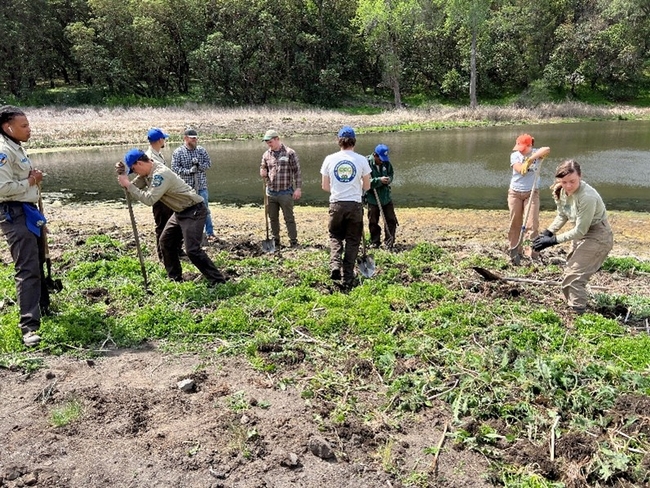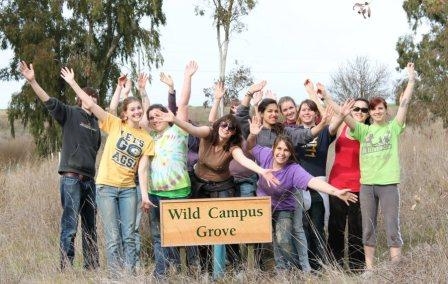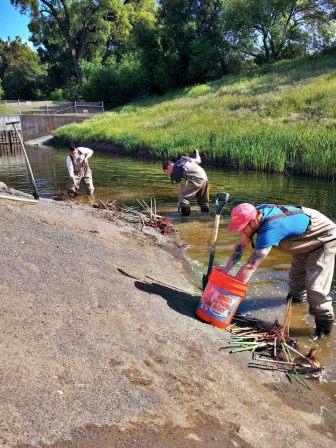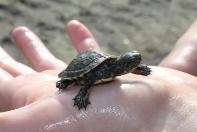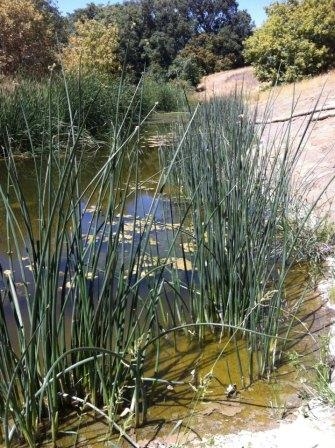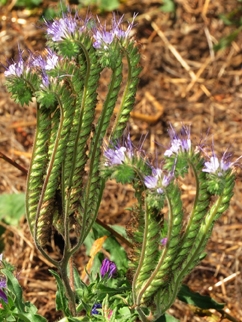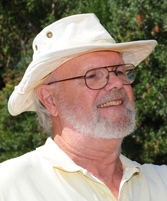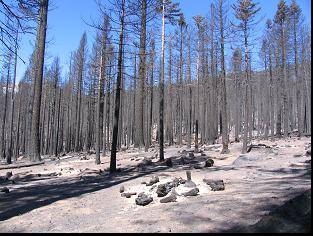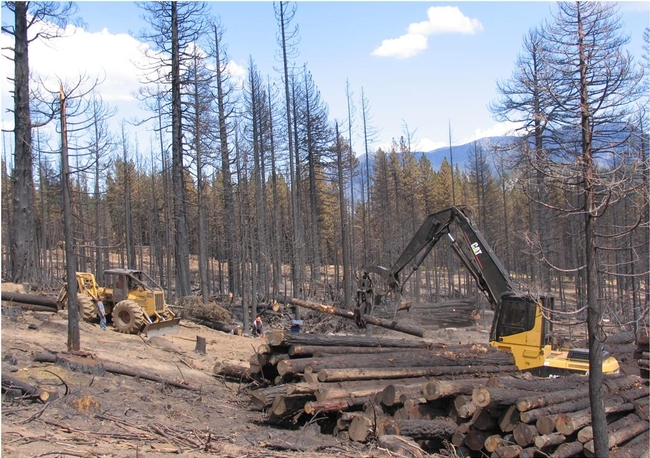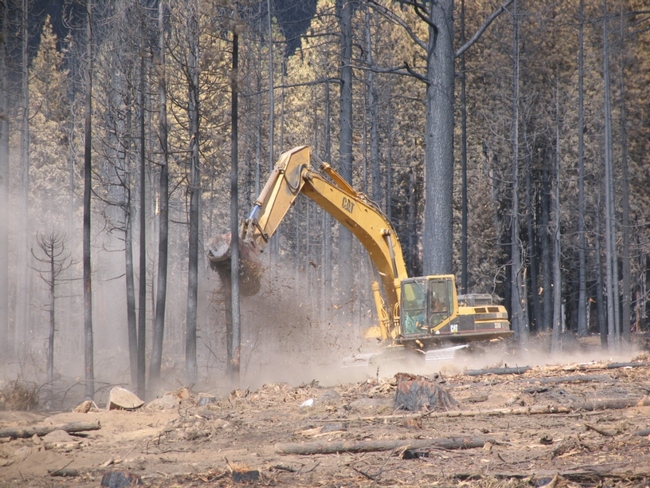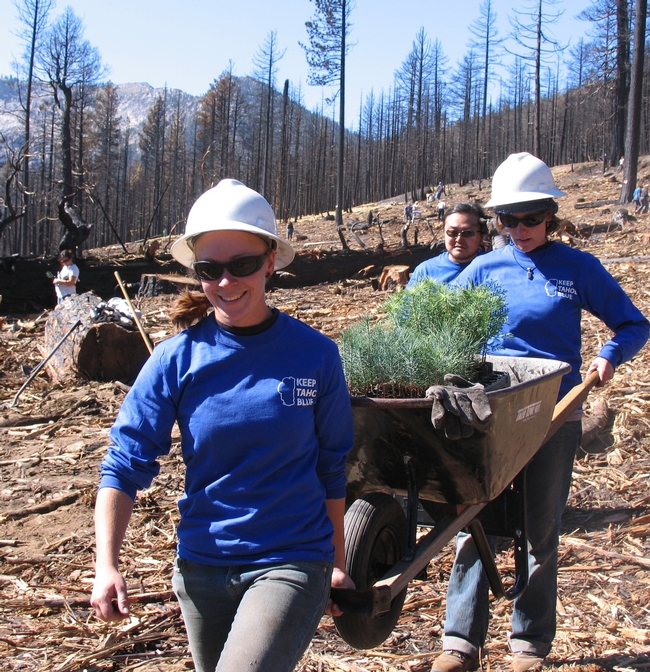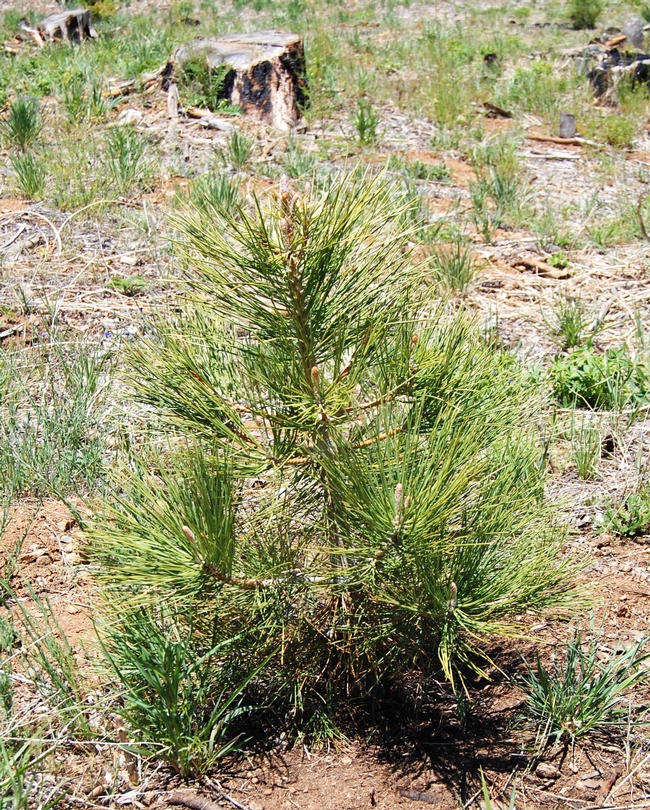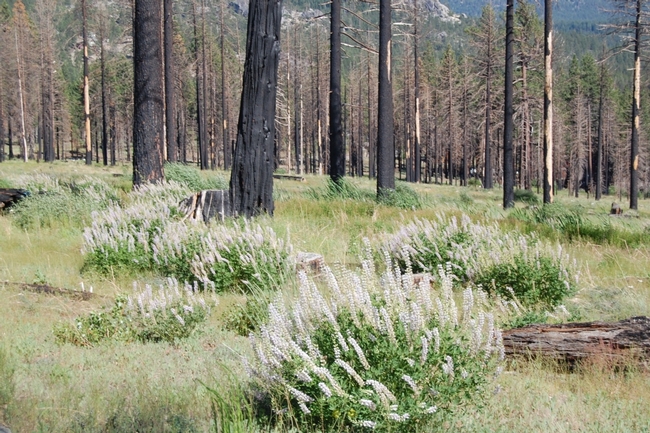Posts Tagged: restoration
Bringing back California’s native frogs
When Al Murphy first took the reins at the UC Hopland Research and Extension Center (HREC) back in the 1950s, he had the joy of listening to California red-legged frogs living in a couple of perennial ponds. Maybe it was the frog chorus or just the rarity of year-round water that made Al and his staff decide to keep the sheep out and declare the ponds a biological area. Despite the designation as a biological area, the ponds have lost a good deal of biodiversity since Al's time.
The native frogs took a beating thanks to bullfrogs and exotic fish such as large-mouth bass that were introduced for sport fishing and by the time Kevin Lunde did his Ph.D. on chorus frogs at HREC in 2011, there were no native frogs to be found in the ponds. Also, by removing grazing and the use of fire to manage the rangelands surrounding the ponds, tule reeds dominate the pond's edge and invasive plants such as vetch spread across the higher ground.
The recent periods of drought are devastating for most of California's ecosystems, but were good news for the ponds. They went completely dry for the first time in recorded history, and the largemouth bass died off. The long, dry period also puts us at an advantage for bullfrog eradication while the habitat for the species is limited. As part of the restoration efforts, HREC staff removed some of the bullrush and community volunteers along with members from the California Conservation Corps spent the day translocating spike rush plants from nearby locations to the recently cleared areas along the edge of the pond to provide additional warm, shallow sunning areas for native amphibians.
Only time will tell if the spike rush takes hold and, in the meantime, we hope volunteers will return to help get rid of some bullfrogs. If we can keep the bass out and the bullfrogs under control, we can look forward to a time when red-legged frogs can safely return to HREC.
Thanks, HREC staff and GrizzlyCorps member Mona Latil-Quinn, for your help.
College students create wildlife habitats in a Wild Campus program
Put together a group of hard-working, do-good college students who care about environmental issues, and you end up with a really “Wild Campus.” At UC Davis, students formed the student-run Wild Campus organization two years ago to conserve wildlife in the greater UC Davis area.
Working with campus experts (such as faculty and staff in the Department of Wildlife, Fish and Conservation Biology) and local environmental and conservation organizations, the volunteer students are improving the habitats for local wildlife and engaging the public in hands-on activities.
This is an extraordinary program that gives the students real-world environmental management skills, along with leadership opportunities and communications experience. Professor John Eadie, Department of Wildlife, Fish and Conservation Biology at UC Davis, said of the Wild Campus program, “Hands-on activity is a huge part of the educational experience.”
In the UC Davis Putah Creek Riparian Reserve, the students are establishing wildlife habitat areas and monitoring populations of amphibians, birds, fish, insects, mammals, and reptiles. They will record the changes over the course of time. Recent work in the riparian reserve (aka “the living classroom”) has included planting native oak seedlings, and installing tule plants to provide protection for the Western Pond Turtle, a species of concern.
A past project — Build a Wild Home Day — involved working with the UC Davis Arboretum on a successful public outreach program to build bird and bat boxes for installation on campus. (Great photos of this program are on the group’s Facebook page.)
The Wild Campus organization has a large cadre of eager and dedicated students who are improvising and making the most of limited resources. However, they are in need of donated field equipment (used equipment is fine) and financial contributions.
Visit the Wild Campus website and Facebook page for a feel-good look at what these ambitious students are doing to improve the environment, along with ways you can help them succeed.
Honey bees: Should they be banned from native plant restoration areas?
What’s a honey bee to do?
The dwindling resources of pollen and nectar-producing plants in California greatly concern bee scientists and beekeepers, and rightfully so.
But the dwindling resources also greatly concern native pollinator specialists and native plant enthusiasts. Some worry that honey bees, which are non-natives, may be "reducing" or "eliminating" native pollinators through competition for food.
Are they?
Extension apiculturist Eric Mussen of the UC Davis Department of Entomology and Nematology explains that a number of agencies and organizations are cooperating in an effort to "restore" regions of the California Central Valley to their "original state."
“The major emphases are (1) replacing non-native vegetation with native plants and (2) encouraging native animals to return to their former ranges,” Mussen says. "The result has been eviction of beekeepers from apiary locations that have been used for decades as seasonal spots for rebuilding populations following the stresses of commercial pollination or for producing honey."
“While removing this non-native pollinator from an environment may sound rational at first, it may not be the best idea,” Mussen points out. “In most cases, it is not the presence of honey bees that has depressed or eliminated the populations of native pollinators. In fact, no studies have shown that honey bees eliminate native pollinators. In some cases, the populations of native pollinators have been reduced by honey bee competition, but following removal of honey bees the native bees built back to usual levels in a couple years.”
Indeed, in some situations, honey bees can survive, and native pollinators can’t.
“With honey bees, if we provide them with an adequate hive and food sources, they are likely to survive,” Mussen says. “However, native pollinators can be very particular about the environment in which they can exist. If their nesting habitat is disturbed, modified or destroyed, they cannot live in the area, despite an abundance of food plants. In many California locations, it is habitat alteration or destruction, not lack of food, which eliminated the native pollinators.”
When native habitats are compromised, “honey bees may be essential to foster initial re-establishment of native plant populations,” Mussen relates. “Those plants provide food and shelter for wildlife and assist significantly in erosion control. Until the habitat is restored adequately to meet the requirements of native pollinators, it is likely that the presence of honey bees will be much more beneficial than detrimental in keeping the California native plants pollinated and reproducing.”
So, should honey bees be banned from restoration areas?
"No," Mussen says. "Honey bees should be solicited for restoration areas, not banned."
Mussen shares a list of 130 native California plants that are likely to be visited - "and probably pollinated" - by honey bees. They include button bush or button willow, fiddleneck, and California golden poppy. The list is excerpted from Nectar and Pollen Plants of California by G. H. Vansell UC Berkeley, plus personal observations by native pollinator specialist Robbin Thorp, UC Davis emeritus professor of entomology. The list is updated, reflecting information on the CalFlora website and the Jepson Manual of Higher Plants of California.
Thorp, who monitors the Häagen-Dazs Honey Bee Haven, planted in the fall of 2009 on Bee Biology Road, UC Davis, has found more than 80 different species of bees - and counting - in the half-acre bee garden. It's located next to the apiary at the Harry H. Laidlaw Jr. Honey Bee Research Facility.
So honey bees and native bees share the resources.
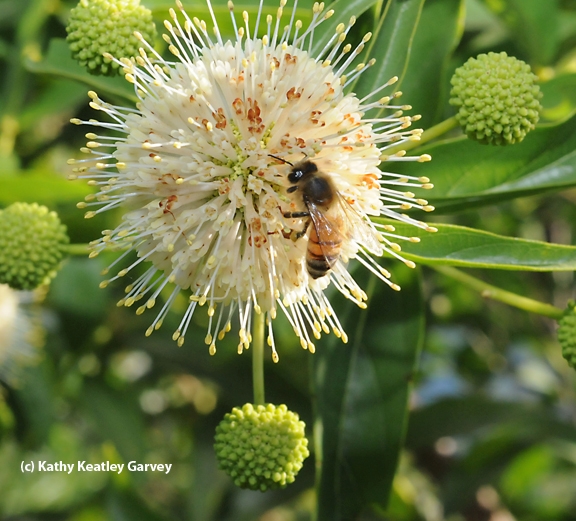
A honey bee foraging on button willow, also known as button bush, Cephalanthus occidentalis. Honey bees on non-natives, and the button bush is a native California plant. (Photo by Kathy Keatley Garvey)
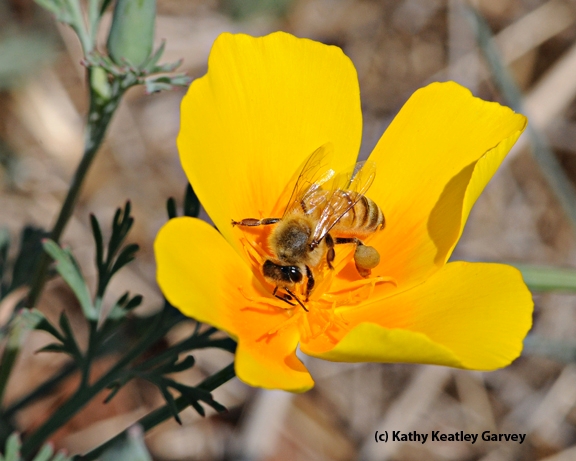
Honey bee visiting California golden poppy, Eschscholzia spp. (Photo by Kathy Keatley Garvey)
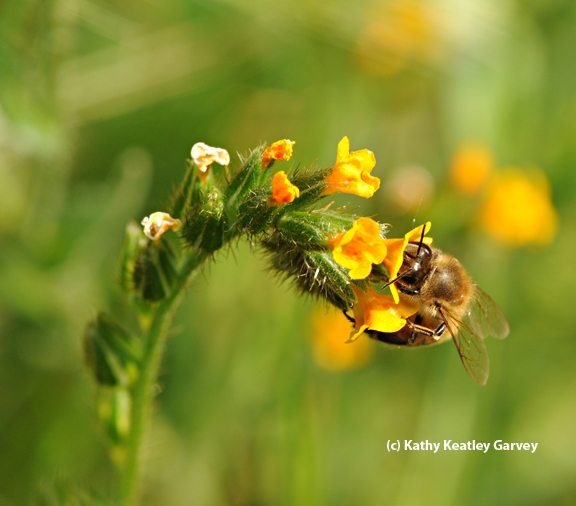
Honey bee foraging on fiddleneck, Amsinckia spp. (Photo by Kathy Keatley Garvey)
Forest lands may benefit from active restoration after wildfire
In the many forested areas where wildfires are currently burning, the question will soon arise: What should be done after the fire goes out? That depends on the severity of the burn and land owner goals.
For high severity burns where very few or no live trees remain to provide seed for the next generation, forest recovery can take a very long time. Typically forest landowners want to restore their lands to a forested condition as quickly as possible. In that case, an active approach can help them reach their goal sooner.
The California Tahoe Conservancy has just released a report on the outcomes of active restoration of 40 acres of Conservancy lands where all trees were killed by the 2007 Angora fire in South Lake Tahoe. That fire burned 3,100 forested acres as well as 250 homes.
Post-fire Conservancy goals were to re-establish a native forest, reduce hazards posed by dead trees, and avoid water quality impacts. Contractors cut large dead trees, skidded them to a landing, loaded them on a log truck and sent to a nearby mill. Some large dead trees were left on site to provide wildlife habitat. Small trees were ground up (masticated) and left on site to control erosion and suppress competing vegetation. Then one- to two-year-old native conifer seedlings were planted.
The report's authors estimate this active approach has hastened the return to a forested condition in the area by about 60 years. This is because planted seedlings are growing quickly while there are few naturally sprouting tree seedlings in adjacent untreated areas and these face competition from vigorously growing native brush that was stimulated by the wildfire. Soil monitoring showed no compaction by heavy equipment during tree removal and minimal soil erosion. Woody mulch left on site was also effective at suppressing brush to give newly planted tree seedlings a competitive edge.
Landowners looking for guidance on post-fire forest management are encouraged to download the free UC Cooperative Extension publication “Recovering from Wildfire: A Guide for California Landowners” and consult the UC Center for Forest Research and Outreach website at http://ucanr.edu/forestry.


